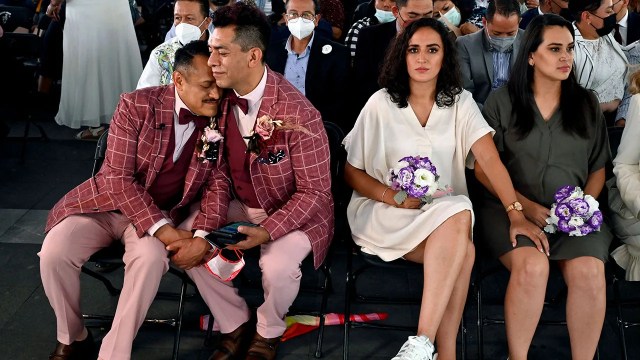
Same-sex marriage is now legal in more than 30 countries and territories around the world, according to a new Pew Research Center analysis. In 24 of these places where detailed statistics are available, same-sex marriages in recent years have ranged from less than 1% to 3.4% of all marriages.
Pew Research Center conducted this analysis to find out how common same-sex marriage is in countries and territories where it is legal. This analysis is based on official marriage statistics from the jurisdictions where same-sex marriage is permitted. In the United States, which does not collect marriage data nationally, we used data from the Census Bureau’s American Community Survey and Current Population Survey to estimate the share of all married-couple households with same-sex married couples. Figures for all other countries and territories represent marriages recorded in the given year.
The analysis used the most recent year for which marriage statistics were available in each country – 2020, 2021 or 2022, depending on the country. For the United Kingdom, that was 2020 because, even though the statistical agencies for Scotland and Northern Ireland had data for 2021, the office for England and Wales did not. (Bear in mind that the number of marriages that occurred in these places may have been impacted by COVID-19 restrictions on gatherings.)
Other jurisdictions were excluded from the analysis because data on same-sex marriages was not readily available. Argentina, for instance, has no single nationwide repository for vital statistics on such topics as marriage. In Canada, some provinces and territories don’t record the gender of marriage partners on their registration forms, so Statistics Canada doesn’t release separate nationwide statistics for same- and opposite-sex marriages.
In South Africa, same-sex marriages are called “civil unions,” but they carry the same rights and obligations as civil and traditional marriages and are considered legally equivalent. Data for New Zealand and Portugal includes marriages between overseas residents or foreigners who got married in those countries.

In Spain, where same-sex marriage has been legal since 2005, 3.4% of the 148,588 marriages registered in 2021 were same-sex – the highest share among the countries and territories for which data is available. (The latest year available is 2020, 2021 or 2022, depending on the jurisdiction.)
The lowest rate of same-sex marriage was in Ecuador, where the Constitutional Court legalized it in a 2019 ruling. In 2021, only 250 out of 56,921 marriages registered in the country, or 0.4%, were between same-sex couples.
Related: How people in 24 countries view same-sex marriage
The United Kingdom had the second-highest share of same-sex marriages among the countries with data available, at 3.3%. However, in the UK, data is reported for three subnational jurisdictions – England and Wales together, Scotland and Northern Ireland – rather than for the country as a whole.
In 2020, the most recent year figures are available for all three units, same-sex marriages accounted for 3.3% of all marriages in England and Wales, 3.5% in Scotland, and 4.2% in Northern Ireland – making the same-sex marriage share 3.3% for the entire UK. Scotland and Northern Ireland have since published marriage data for 2021, with same-sex marriage rates that year of 3.4% and 5.0%, respectively, but the Office for National Statistics for England and Wales has yet to do so.

Twenty of the jurisdictions that had data on same-sex marriages distinguished marriages between women from those between men. In 16 of these places, a majority of same-sex marriages were between two women. The biggest disparity was in Taiwan, where 1,794 of the 2,493 same-sex marriages recorded in 2022, or 72.0%, were between two women. The highest share of marriages between men was in Costa Rica, where they comprised 370 of the 677 same-sex marriages (54.7%) recorded in 2022.
Directly comparable figures for the United States aren’t available because marriage registrations are kept at the state and local levels rather than nationally, and not all jurisdictions keep separate counts of same-sex and opposite-sex marriages. However, the Census Bureau estimates that as of 2021, 711,129 of the nation’s 61.3 million married-couple households, or 1.2%, involved same-sex married couples. As in many other countries, households with two married women were more prevalent than households with two married men in the U.S., accounting for 52.6% of all same-sex married-couple households.
Overall, Gallup estimates that as of 2022, 7.2% of American adults identify as “lesbian, gay, bisexual, transgender or something other than straight or heterosexual.”
